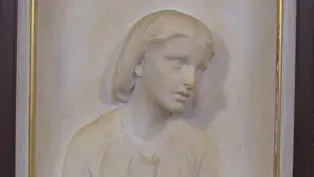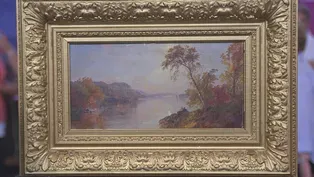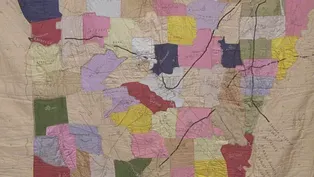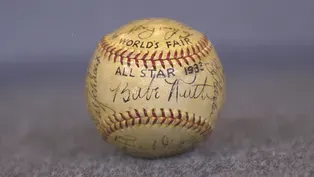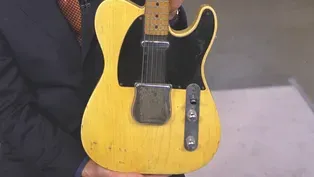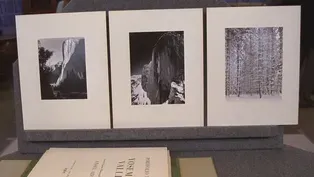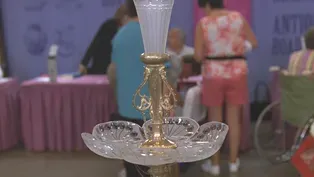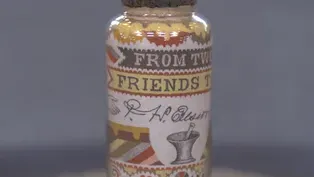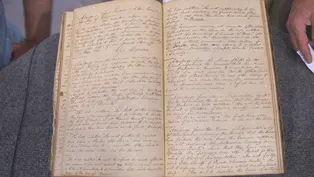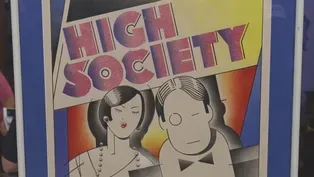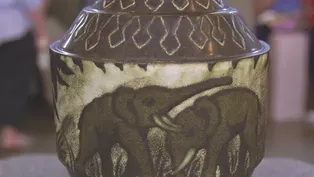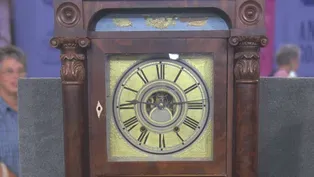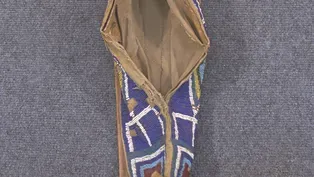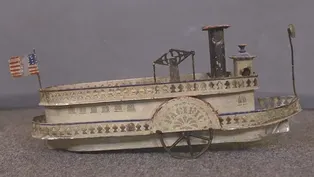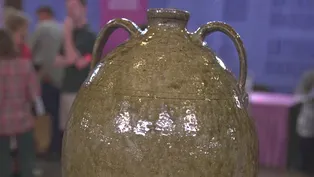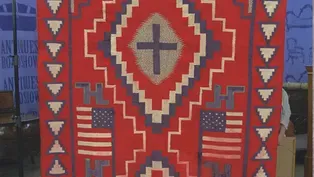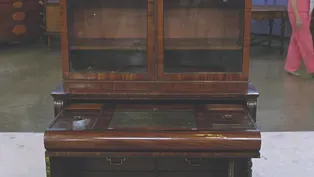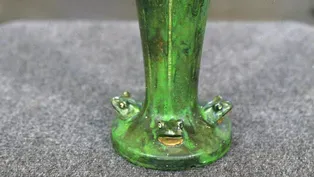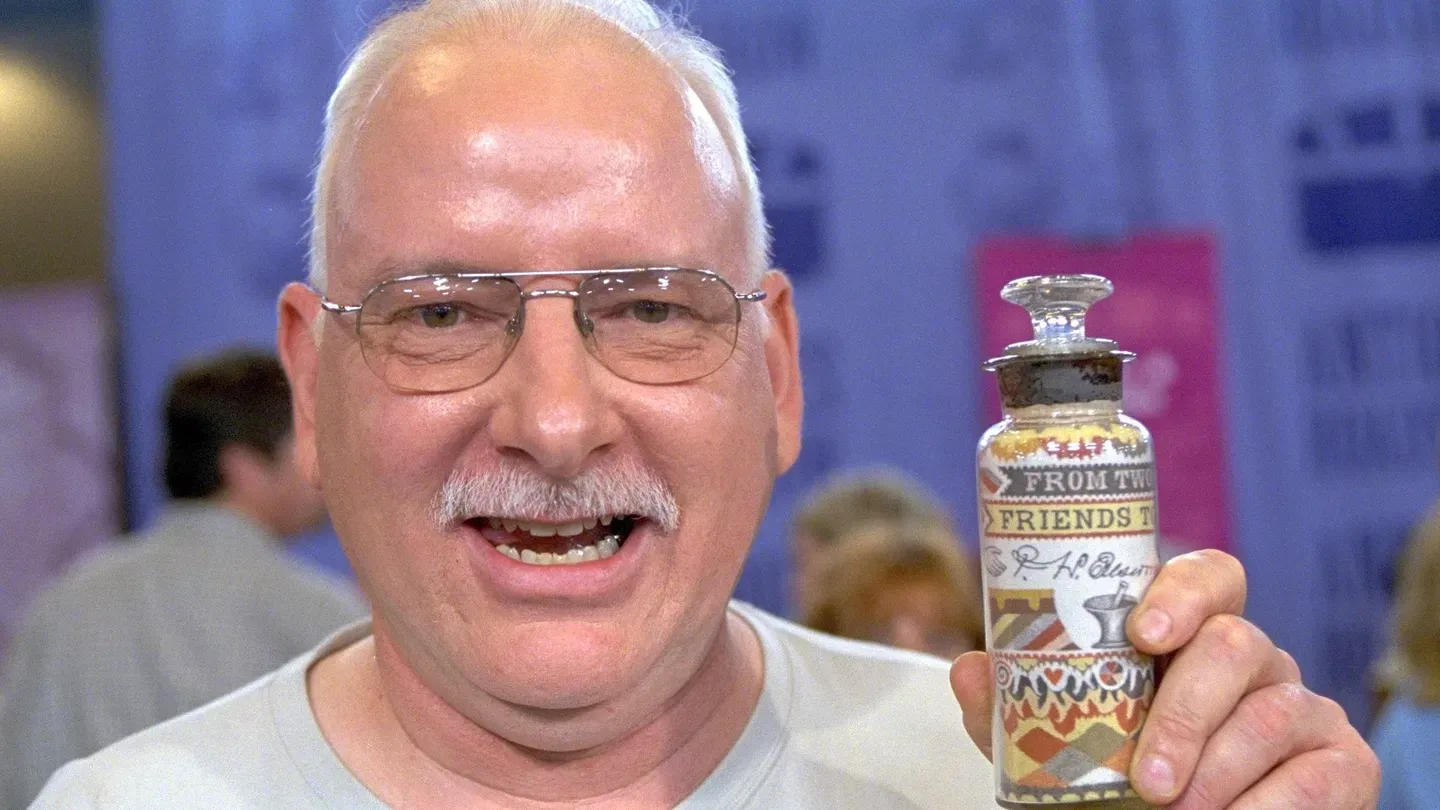

Vintage Hot Springs
Season 21 Episode 20 | 52m 25sVideo has Closed Captions
Discover how appraisals from 15 years ago have changed in the market!
Discover how appraisals from 15 years have changed in the antiques market, including Andrew Clemens sand art, ca. 1880, a 1933 All-Star game signed baseball, and an 1886 Jasper Cropsey painting. Can you guess which item is valued at $100,000?
Problems with Closed Captions? Closed Captioning Feedback
Problems with Closed Captions? Closed Captioning Feedback
Funding for ANTIQUES ROADSHOW is provided by Ancestry and American Cruise Lines. Additional funding is provided by public television viewers.

Vintage Hot Springs
Season 21 Episode 20 | 52m 25sVideo has Closed Captions
Discover how appraisals from 15 years have changed in the antiques market, including Andrew Clemens sand art, ca. 1880, a 1933 All-Star game signed baseball, and an 1886 Jasper Cropsey painting. Can you guess which item is valued at $100,000?
Problems with Closed Captions? Closed Captioning Feedback
How to Watch Antiques Roadshow
Antiques Roadshow is available to stream on pbs.org and the free PBS App, available on iPhone, Apple TV, Android TV, Android smartphones, Amazon Fire TV, Amazon Fire Tablet, Roku, Samsung Smart TV, and Vizio.

ANTIQUES ROADSHOW 2025 Tour!
Enter now for a chance to win free tickets to ANTIQUES ROADSHOW's 2025 Tour! Plus, see which cities we're headed to!Providing Support for PBS.org
Learn Moreabout PBS online sponsorshipIt is the Mack Daddy of Niloak Pottery.
Elizabeth.
(laughs) Who would have ever thought that you could dig something like this up, and it'd be worth that much?
MARK WALBERG: When talking market, new collectors with new tastes impact value.
As the modern market matures...
There's a demand for it that there has not been before.
The demographics are also changing in America, and I think that there will be more and more interest.
WALBERG: Let's revisit our 2002 Hot Springs, Arkansas, stop and see how today's collectors have changed those values.
Well, it's a... we're not really sure what to call it, but it's colored sand in a jar.
And it was presented to my great-grandfather around the end of the Civil War.
He was a sergeant in the Union army, I believe from New York, and they moved to Hot Springs after the Civil War and settled here.
And this was a gift from two of his friends, and it's been in my family ever since.
And what do you do with it now?
We look at it, it sits on the bookshelf, and we enjoy it.
Do you keep it in a safe place?
No, we keep it high enough where my four-year-old granddaughter can't reach it.
Yeah, please do.
Well, let's start with, you know, what it is.
It is... it's sand in a jar.
But what sand in a jar.
It's an incredible piece of sand art.
Let's start with who your great-grandfather was.
He didn't come from New York, he came from Illinois.
Close enough.
And he spent most of his Civil War career in the Hot Springs, Arkansas, vicinity.
The real interesting thing about this remarkable piece of sand art, though, is just what you see here.
Not only is his name on it, but on the back you see this wonderful eagle with the 36-star flag.
You spin it around, you see his name is written in script, there's a mortar and pestle.
All of this is done with individual grains of sand.
And when you flip it up, the label on the bottom says, "Pictured rock and sand by A. Clemens, deaf-mute" from McGregor, Iowa.
While you were sitting back in the green room, on a whim, while I was finding out about your grandfather, I went to the internet and just typed in "McGregor, Iowa, sand."
And bingo, we got a hit.
Really?
On A. Clemens, the guy who made this.
When he was five years old, he had what his family called "brain fever."
And he went to the deaf-mute school in Iowa, and would come home in the summers, and he started going to this spot on the Mississippi River in McGregor, Iowa, and collecting sand, and sort of experimenting with making these bottles.
He used a big fishhook, a great big oversized fishhook, and, like, a popsicle stick.
And he would take the sand that he'd collect along the Mississippi River, and then he would pack it in this bottle, and manipulate it with the fishhook.
He gained national fame for making these, and today, there's an exhibit on this guy at the Iowa State museum.
Is that right?
It is a remarkable piece of folk art.
On today's market, I would guess that it's between $4,000 and $6,000 is what we'd estimate.
Really?
It might bring more than that in the right auction-- great piece.
That's great.
It belonged to a friend of mine who was terminally ill, and he knew that I was very interested in Art Deco, and really liked this print, and lucky for me, he left it to me when he passed away.
Now, you told me that you had this piece appraised.
I had it appraised at one time, yes.
And can you tell me what the appraiser told you?
She couldn't find out any information about the artist whatsoever.
Just on looking at it and the fact that it's Art Deco, and I suppose the age, she appraised it at $2,500.
At $2,500.
Well, I'm going to tell you something.
The piece isn't real.
It's not real?
Now, let me make this clear to you-- the piece is not a reproduction.
Okay.
The piece is a complete fabrication.
And it was made to look like the most perfect Art Deco poster ever.
Okay.
It's done in a style that I like to call "Hyper-Fitzgerald."
I mean, it's absolutely like The Great Gatsby, it's...
Right, it's way out there.
It's got everything.
It has the martini glasses, the monocles, the red lips, it's got the stylized angles.
It's got everything.
Right.
But it was done in the 1980s, and it was made to look like it was created in the 1920s.
Okay.
And, in fact, the people who made it even put the date on it.
They dated it 1928.
Correct.
Which is, in fact, a complete lie.
Fabrication.
Now, there's an organization in America called the International Vintage Poster Dealers Association.
Okay.
And they have spotted this poster as a renowned fabrication.
Okay.
And they can date it because of the paper.
Okay.
They can date it because of the inks.
Okay.
If you were to take this out of the frame, you would find out that the poster is mounted on linen.
Okay.
Because the people who were making the poster didn't want anybody to touch the paper.
Because if they touched the paper, they'd find out that it was really modern paper.
Okay.
So they mounted the poster on linen.
So much for the bad news.
Okay.
Now let me tell you the good news.
Okay.
It is an incredible Art Deco image, and if you ever are in the market to resell it, as long as you make it perfectly clear to the person you're selling it to...
Right.
...that it is not, as stated, from the 1920s, but from the 1980s, it would sell, and does sell for between $700 and $1,000.
Now, if it really were from the 1920s, it would certainly be worth $2,500 or more.
Right.
The funny thing is that the people who made this, their biggest mistake was putting the date on it.
Okay.
If they hadn't put the date on it...
It'd be harder to tell.
Well, not only harder... if they just sold it as a contemporary decorative print, it might actually sell for more.
Okay.
But now poster dealers are a little bit nervous to handle it, because they know it's a fabrication.
APPRAISER: It was done in 1869, the year that Grant was inaugurated for his first term as president.
George Washington is the father of the nation, Lincoln is the savior.
U.S. Grant is the custodian of the nation.
I'd put about $1,200 on it.
Oh, wow, that's great.
Yeah, it's a wonderful piece.
This opens up into a writing surface.
It's a portable lap desk.
I would say auction value between maybe $1,500 to $2,500.
How about that?
All right, great-- that's good news.
They're quite a beautiful pair of girl's... what we call high-top moccasins.
Probably out of the Oklahoma area, and probably Southern Arapaho.
They look to be in almost unused condition.
I think they're an exceptional pair and probably in the $3,000 to $4,000 range.
Oh, wow.
My goodness.
My grandfather gave this to me about 32 years ago.
It's Niloak, I know it's Mission swirl.
That's about all I know about it.
And you know where Niloak is from?
Yes, Benton, Arkansas.
Benton, Arkansas.
And that's about it.
Do you know what Niloak means?
No.
Niloak, which is spelled N-I-L-O-A-K, means "kaolin" backwards.
And kaolin is an important ingredient in clay when you're making pottery.
Something to put in there.
Okay, this pot is remarkable because, as you may know, it is the Mack Daddy of Niloak pottery.
It is the biggest piece of Niloak I have ever seen.
And I've handled a lot of Niloak, all right.
This is the earliest production of Niloak before they went into the glazed stuff.
This is Missionware, and it started about 1909, 1910.
Okay, so this was their... sort of their addition to the Arts and Crafts movement.
And there is no glaze on this.
Only swirled clays, which make the decoration.
Any idea what it's worth?
No.
It's hard to say because it's not the kind of stuff that you see all the time, all right?
So it basically depends on a couple of people deciding how much it's worth.
So, at auction, it would go anywhere from $3,000, upwards of $5,000 or $6,000, all right?
But a minimum of $3,000, and after that, who knows?
Well, this piece is in the family and it was inherited down.
We don't know much about it, we just know it's very unique.
It sits on a table in my aunt's house and we all admire it just because of the uniqueness of it.
We've never seen nothing like it.
Okay, and so you take pretty good care of it, then?
Well, we make sure no kids hit it or nothing but we've been scared to kind of clean it because we don't know what to clean without getting in trouble.
And have you heard theories about cleaning things, or...?
Oh, yes.
We watch this Antiques Roadshow all the time.
And so we know not to take the special patina off of the item, so...
So, you're very careful.
Very careful.
Well, what you have here is a 19th century epergne, and that's a little bit fancy name for a flower vase and sweetmeat container.
This lifts out and the flowers go in the top.
And then some type of sweetmeat in the center part of the piece.
This piece, in the condition it's in, has much lesser value than if you do clean this piece.
This is a piece you would take to a professional silversmith and have them work on it, and it isn't a lot of work.
It's basically a good cleaning.
Yes, ma'am.
They are very careful with the patina, so you wouldn't lose the natural patina.
You also noticed on here a certain mark?
Yes, ma'am.
On the swan and underneath the swan.
And under the swan.
And because we haven't taken this apart, we did try with a magnifying glass, but couldn't exactly see it all.
So that mark will show up when you take it in for the cleaning process.
The swans on the bottom are extremely rare.
Has a little bit of damage around the top, which hurts it a little bit, but given that, in good condition, which, again, would not be a big project.
I presume there's a silversmith in the area.
Well, probably near us.
We live in a little small town.
Well, definitely take it to a silversmith and then you would have a piece that's in the $2,000 range.
Oh, no kidding!
Oh, man!
So, a nice present, and I do thank you very much.
Thank you!
I'm having a blast.
Oh, great.
Are you serious about that?
Yes, I sure am.
I sure am.
It's that old?
Yes, it's a wonderful piece.
WOMAN: My husband's grandfather was a friend of a baseball great, Bill Dickey.
And Bill Dickey must have been a very generous man because he gave a lot of baseball memorabilia from his career to my husband's grandfather, and my father-in-law gave this baseball to my husband and me.
So, what we have here is the American League team from the very first all-star game, 1933.
It was played July 6, 1933, in Comiskey Park in Chicago in conjunction with the World's Fair.
A gentleman named Arch Ward actually came up with the idea, and this baseball represents that team.
This team was a juggernaut.
It was amazing, as you can see by some of the names on this ball.
The most important, of course, Babe Ruth, signed the sweet spot, as you can see.
We have two other greats.
Jimmie Foxx, right here, and Lou Gehrig, right there.
A beautiful ball.
And amazing that it kept its condition through the years.
Part of that was due to the fact that somebody, maybe Bill himself, shellacked this ball.
Now, sometimes, shellacking does damage to the ball, and it all depended on the type of shellac used back then.
Sometimes it browns it, and sometimes the signatures are obliterated completely.
But in this case, they preserved it.
"Provenance" is a word we use a lot here on this show, and, of course, that's the history of the piece.
And this baseball in particular has a great history because Bill Dickey, one of the actual members of the team, gave this to your husband's grandfather.
That's right.
So, that's amazing provenance.
Do you have any idea what this might be worth?
It would just be a stab.
I mean I would think at least a few thousand dollars, but really... Yeah, a few thousand.
But I don't have the kind of knowledge to say.
Well, I would add about 20 ...to that number.
Oh, my goodness!
Because a baseball like this, in this condition, with that sort of provenance, is $20,000 to $25,000.
Oh, my goodness!
That is just wonderful!
Without question, it's one of the finest 1933 All-Star game balls I've ever seen.
Oh, I am so pleased!
And it was a real pleasure to meet you and to see this great ball.
Oh, thank you so much!
Thank you.
Very good.
I got it at an estate sale.
We were just going through the rooms, and I saw this on the bed in one of the rooms and I asked the lady about it, and she said that it had belonged to a Civil War veteran who had lived there, and I just fell in love with it.
I like Indian things, and thought, well, "I've got to have that."
What did you pay for it?
$20.
Bargain day.
Yes, yeah.
First of all, it's a Navajo weaving.
It was done by a Navajo woman in New Mexico or eastern Arizona, probably.
It's called a Germantown.
Germantown.
And it's called that because a lot of this yarn was made in Germantown, Pennsylvania, and shipped to the West for the best Navajo weavers.
When I look at the warp lines-- and the warp lines are the lines that... the threads that run up and down inside of this-- there's red ones and they're four-ply.
And that tells me it was made between 1890 and 1910, roughly.
Okay.
The design's great.
It's a floor rug, because of the pattern around the edge.
It doesn't date back to the Civil War, but you know...
The flags... you don't see those on Germantown weavings much.
There's some problems.
The problem is the condition.
Uh-huh, yes.
You've got holes, you've got bleeds, all kind of moth damage, ravels on some of the edges.
If you were to take this out and sell it right now, it's worth probably $2,500 to $3,000.
Really?
Oh, well, that's great.
Which is still pretty good on your $20.
Yes, it certainly is.
Now, if you decide to go and have it restored, that changes the whole picture.
It's going to cost you $3,000 or $4,000 potentially.
Uh-huh, yes.
These are fine weavings that take special yarn and a very qualified individual to repair it.
Yes, uh-huh.
At that point, the picture changes.
You've got a weaving worth $8,000 to $10,000.
Oh, well.
But it's a great thing.
Well, yeah, I think it is.
It's a beautiful piece.
Now you have to decide where you want to go from here with it.
Yeah, uh-huh.
APPRAISER: The beam rocks back and forth to imitate the action of a steam engine, and this rocking back and forth is also the pendulum.
When did you buy this?
MAN: About four years ago.
I gave $1,000 for it.
I think it's worth about $2,500 because of the condition.
It's all-original and these are hot items now.
A lot of people love to collect these.
APPRAISER: It's known as a corsage brooch.
And another little trick that it does is when it's on, the sapphires tremble.
And it's called en tremblant.
Because the leaves move, and the stamen move, that makes it about 20% more valuable than it would if it were stationary.
WOMAN: I probably didn't pay more than 50 cents for it.
50 cents?
Okay.
All right, good.
This is an early 20th century René Lalique-- stamped here "R. Lalique"-- pendant.
I would say a good estimate on it would be $600 to $900.
Really?
Yes.
I'm real shocked.
Not bad for a buck, huh?
And not bad for less than a buck.
WOMAN: This is a Mark Twain original manuscript page, number 223, from his unfinished Among the Indians.
And one of the things we were talking about, why it was unfinished.
He started to get a lot of sexual content in it, and his wife didn't approve, so she said, "Stop."
So they stopped, it's unfinished.
Pages of Mark Twain's manuscripts, like this, where it's actually in his hand, a book that wasn't published, didn't come out, are quite valuable.
I mean, they're hard to get, and Mark Twain's one of the icons of American literature.
This page would be worth about $5,000 to $7,000.
Anyways, you're just not going to get things like that.
You are kidding, no... oh, my goodness.
Well, it's a great item.
Wonderful!
Oh, my goodness, my daughter will be so glad.
She's an only child, so... And we're from Missouri originally, so this is just so appropriate for our family.
Well, my mother-in-law was walking out to the pear orchard, and we went through the barn loft, and I saw the frog's head sticking up out of the ground.
You said you were pregnant at the time?
Big pregnant, with my third child.
This is how long ago?
50 years ago.
So you saw the frog's head sticking out of the dirt?
Yes.
We walked right by and it didn't move, so I just swished my foot across it, and it still didn't move.
And I told my mother-in-law that I was going to go back to the barn and get a shovel and dig down and see what this is.
So, I got it, and I dug it up, and there was not one blemish on it.
Not a crack, chip, or anything.
So that's how I found this vase.
And in 50 years, there still isn't a blemish on it.
Yeah, true, and four children, and all those grandchildren you asked me about.
And you have no idea who made this?
No idea whatsoever.
Well, there's a good reason for that because there is a mark on the bottom, but it's kind of blurry.
And I've seen the mark before so I know what it is.
It says "Weller Pottery," and that's a kiln that they fire pottery in.
So that's from the Weller Pottery from Zanesville, Ohio, one of the more famous companies.
This is a production piece.
It's not a one-of-a-kind artist piece.
They made a number of these, sometime around 1925, 1930.
It's called their Coppertone line.
But it's a particularly good piece of their Coppertone line.
And the last one I sold, I sold for $2,800.
And I think this is a $2,500 piece and could bring as much as $3,000, right in that price range at auction.
Oh my.
So it's a really good production piece.
Well, golly.
Who would have ever thought that you could dig something like this up and it would be worth that much?
So you spoke to your son, the one you were carrying when you found this?
Yeah, yeah, and he said, "Well, she should leave it to me because I was with her when she found it."
(chuckles) A very good friend of mine who I used to go antiquing and flea-marketing with and everything for years and years, passed away.
Her family allowed me to go to the estate sale a day ahead of time and I purchased it.
Uh-huh.
Her husband had been from New York and she was from New Jersey before she came here, and she met me when I first came here, so we just had always been friends.
And you think she brought this from New York, or she bought it locally?
I think so now, just because I did research the person who signed it.
Right, and it's a New York artist.
Right, and that's all I really knew.
I wasn't even sure what it was made of.
I just knew... to me it was always like it's coming out of water.
Coming out of the background.
Yes.
It's by a New York artist named Erastus Dow Palmer, and he was one of the leading American sculptors in the 19th century.
In fact, his most famous work, the White Captive, is at the Metropolitan Museum of Art in New York City.
Oh, wow.
So he's a very, very important artist.
He actually started his career as a carpenter.
And he became interested in cameos-- you know, Italian cameo carvings?
Yes.
And for a number of years in the 1840s, he traveled around the United States carving people's portraits in cameo.
Whoa.
He settled in Albany, New York.
He was largely self-taught, and what's unusual about him is he actually stayed in the United States and continued his career.
All the other sculptors of this generation, neo-classical sculptors, they all went to Italy to study and to be near the quarries, and also to use the Italian craftsmen to carve their works.
This is wonderful.
It's made out of marble.
As a matter of fact, it's made out of Carrara marble.
And Carrara marble is a very, very white marble, and it's sort of sparkly.
And you wouldn't know from looking at this because this is sort of stained and dirty.
Yes.
This yellowish...
Yes, I wanted to know how to clean it.
Well, I'm not going to tell you how to clean it, because you shouldn't clean it.
Okay.
That's why.
This sort of yellowing is basically from nicotine and smoke.
And at one time, I don't know if you can look in the frame, but it actually had glass here in it.
And so it was protected by glass.
And at some point that glass broke and it was affected by the smoke.
And, basically, what you have to do is you have to have a professional conservator who can take care of this, who can clean it, who can bring it back to normal, the way it's supposed to look again.
This is supposed to be very white, with these wonderful sparkles in the background.
And it would not really affect the value, the fact that it's dirty and that it's been cleaned.
Mm-hmm.
Now, you say you bought it at an estate sale and how much did you pay for it?
$500.
$500?
Well, that was pretty... it's a good amount of money.
It's a big purchase for me.
It's not like buying it for five bucks at a yard sale.
Right, right.
His work is very rare, his work is very desirable.
I would think this piece at auction would bring in the $15,000 to $20,000 range.
Oh, wow.
(laughing) Okay?
Great.
Well, this is a portfolio that I purchased from Ansel Adams in 1964.
Uh-huh.
I went to my first museum job and I thought this would be a great opportunity just to have a small exhibition of Ansel Adams' work, and so I wrote him and we bought the portfolio.
These are three representative images from a portfolio of 16 photographs that Adams did of the Yosemite Valley.
These photographs were done over a period of almost 40 years.
In 1926, Adams took his first trip to Yosemite, made some photographs at that point, and continued to go back.
Now, what's important is that they're signed by Adams.
They're also archivally mounted.
Adams was very concerned with the proper presentation of his photographs.
He developed the craft of very fine photographic printing, and these prints were done around 1960.
So they're referred to as modern prints that Adams crafted from the original negatives.
And, as he made these later prints, he reinterpreted them.
And in many ways they are very symbolic, I think, of his passion for the environment, and making people aware of the American landscape.
What did you pay for these images when you acquired them?
The portfolio was $100.
$100?
In 1964.
At auction, I would estimate the 16 photographs in the portfolio at $30,000 to $50,000.
(chuckles) A bit different from its 1964 price.
I got it at an estate sale about four or five years ago, and I happened to see this and just had to have it.
Have you tried to do any research on it or...?
I've tried to, but all I could find was like a smaller jug, and all they said was that it was a Southern jug.
A Southern jug, yeah.
Yeah.
And it didn't really compare to this one.
It was so much smaller, and it didn't have the small neck on it either, so...
Okay.
Well, it is indeed Southern.
So the book that you were looking in was correct.
And it is a type of jug that was made throughout the South.
It has this wonderful what we call alkaline glaze, this sort of greenish glaze to it.
And people who collect pottery get really excited about the fact that you can sort of see the drips in the glaze.
The more drips you can see, the better it is.
Oh.
And this one is a very, very handsome example of that.
I like it.
And you can see, too, that it has only a little bit of decoration here, an incised line decoration that was done while the piece was on the wheel, before it was fired.
It's a classic ovoid form that you see from really mid-19th century throughout the rest of the 19th century, and into the 20th century.
Do you mind telling us what you paid for this?
I paid $50.
$50?
$50.
Well, you made a very good buy.
If I were to sell this, I would ask somewhere between $1,800 and $2,200 for it.
Oh, my God!
It's a wonderful piece of Southern pottery.
WOMAN: I found it at the diamond mine in Murfreesboro.
APPRAISER: Do you know the weight of it, because you had it certified?
Yes, it's 22 points.
22 points-- little under a quarter of a carat.
You found a great diamond here, because it's a little on the yellow side.
So, that's also important.
It's not a big diamond, but in today's market, I think this stone would probably be worth somewhere between $600 and $800.
Wow, that's more than I thought.
We see a lot of these bisque figurines.
Uh-huh.
But what's so wonderful about this set is the condition of the box and that all the figures are in such nice condition.
And you just couldn't ask for a better example of this.
I'm sure glad you brought it.
Okay, thank you.
This is a land grant in Ohio, signed by Washington as president.
The presidents stopped signing land grants in the 1820s.
Oh, really?
Jackson was the last one to actually sign his own land grants.
It just got to be too much work.
I didn't know that.
And I would put an insurance value on it of around $12,000.
You're kidding.
You seem surprised.
Thank you.
MAN: It was purchased in Scotland by my brother while he was serving in World War II.
And then he gave it to me as a gift, which I'm very grateful for.
Yes, that is a very nice gift to have.
I was interested to see it, because I... you can probably tell from the accent, I'm from Scotland.
And this artist is actually from my old town of Edinburgh, Robert Gemmell Hutchison.
I was intrigued to see the label on the back here.
90 George Street, Edinburgh.
I started off my career just a few doors along from where they used to be, so it was nice to see this today.
This is an example of Gemmell Hutchison's early work.
He was very influenced by the Dutch school, in particular the Hague school.
And some of the early ones are fairly dark.
And this is typical work of that period.
The later ones tend to be more impressionistic, and often it's children playing on the beach.
And they tend to be, on the market, a little bit more popular, but there'd certainly be demand for this one.
I would say this comfortably ought to make $8,000 to $12,000.
(gasps): Good grief!
You were surprised.
Fantastic!
We're going back to Scotland.
That's dollars, not pounds, remember.
But no, he's a very popular artist.
He sells very well.
Could we give you a kiss?
(laughs): I'd be delighted.
This was a gift from my parents.
They bought it for me when I was a child.
My dad bought it at an auction at DeValls Bluff, Arkansas, and paid somewhere between $40 and $50 for it.
We've got this wonderful little tea set for one.
We've got a cup and saucer here.
And a tray to put everything on.
We've got a sugar bowl, and then here is the little teapot.
And this set has marks all over it.
It's really nice when things are very well-marked.
If we look at the mark here on the bottom it says that it was made in Limoges, France, by the Theodore Haviland company.
It also says "déposé," which is kind of like copyrighted or patented.
And then also on the tail is the signature of the man who designed the set.
And his name was Edouard Sandoz.
Okay.
Haviland was famous for making sets of china, like you eat off of, and they made big sets of china.
They shipped absolutely millions of them to the United States.
There were plain ones, fancy ones, sets of every kind.
Starting in the teens, they began to lose their business to china made in the United States and other countries.
And so they were trying to think of ways to increase their business.
And one thing that this company did is they hired a famous sculptor whose name was Edouard Sandoz.
And this is one of the things that he designed.
It's highly collectible by people who like his work, but it's also highly collectible by Haviland collectors.
I've known a number of Haviland dealers over the years, and whenever they get these pieces in, they don't sell them.
They keep it for themselves.
You don't really see that much of it.
The set was discontinued, and then after the war it was so popular with collectors, even starting as early as the '60s, that in the '70s it was reissued under the Haviland name for Tiffany and Company.
Oh!
But those pieces are clearly marked.
They are still made by Haviland but they're clearly marked as reproductions.
These are old original ones.
And it's really wonderful that you've got the whole set.
It's all in great condition.
This set is probably worth at least $2,000 to $3,000.
Wow.
So your father's $40 investment for his adorable little baby girl has turned out to be a little bit of serious money here.
Right.
I plan to save it.
I will have a granddaughter someday.
So this will be hers.
Well, hopefully you will, and that will be great for her.
And if not, maybe you'll have some grandsons who will like it.
That's right, that's right.
It was purchased by my grandmother we think in the early '50s from an antique store in New York.
And on this invoice or a listing of furniture, it lists an English writing secretary.
And it has a price and a date.
But we don't know anything about it.
It's lived at the top of the staircase out here at the lake house for the last 50 years.
And when we cleaned it out to bring it down here, I found some letters that I wrote when I was in camp 40 years ago to my grandmother, and my archery diploma.
We just don't know anything about it other than it's a cute piece, it looks nice.
You said it had a date and a price.
What was the date and price?
The date was 1750, and I think the price was $700 or $800.
Right.
Well, I would describe this as a regency gentleman's secretary bookcase.
And instead of 18th century, I would push it into the 19th century and probably date it about 1815.
It has a wonderful classical pediment on it.
Another thing about regency furniture is that if you notice, it's all done in beautiful mahoganies.
These are veneers.
They used veneers for two reasons in the regency period.
It was less expensive, but also they were running out of great, great wood.
And as you can see this piece, it's got wonderful wood on it.
All of this great shimmering...
This is mahogany here?
Yes.
And the details in black are ebony.
That's a type of wood?
Yes, it is.
Yes.
You can see also a brass mount down the front of the secretary as well, which decorates it.
It's all very orderly.
We've got our books up here.
This is where you'd have your writing surface.
This is a nice little feature.
You can place...
Didn't know that!
That easel up, it's got its original leather surface.
We close it up and let's entirely close this piece.
Pick up and push back.
And it just rests on here.
Yep, and then you close it up.
Neat.
Orderly.
Neat.
This Grecian design in the early 19th century was considered extremely modern.
It has just a very sleek look to it.
Well, I'm just delighted to know more about it.
Is this original glass?
It looks to me as though it is.
It has some wonderful wavy qualities to it.
Again another part of this piece which drives its price and value up.
You have an inventory that says its worth $750.
I think that's modest.
You think so?
I don't think I could probably buy this for $750 today.
So if I was going to make another inventory for household insurance or such, I would probably put this on at the $15,000 range.
Wow!
So you need to bump that up a little.
I may need to bump up some insurance.
That's just great.
I understand you've had this model cradle in your family for quite some time.
Yes, since the late 1890s.
Since the 1890s.
Was it your grandfather that sent it to you?
My great-grandfather sent it back to his grandchildren.
And he was in New Mexico.
He went out there to teach the Indian children.
Do you have any idea what tribe made this cradle?
I have no idea.
And how about value, have you ever had anybody look at it?
Well, I took a photograph to a dealer, and he said, he offered me $1,500 because of the pink beads.
Because of the pink beads, that's interesting.
That pink bead color is called Cheyenne pink in the Plains vernacular.
Oh, I didn't know that.
But the Kiowa and Comanche both made this type of cradle.
I actually think this one is Comanche, which is a little rarer yet than the Kiowa.
You can see the great beaded pattern down this side.
And unfortunately, through a hundred years of playing with it, the other side is missing a little of the bead work.
It's not quite as nice.
It's beaded on a muslin, and there's a rawhide liner for the hood.
The drop is still here.
This was buck skin, and this was dyed yellow at one time.
Oh.
And it's a little bit stiff, but it's still not too bad.
These model cradles were obviously modeled off of a large cradle for an infant.
And they're very desirable.
Anything Kiowa, Comanche from the 19th century is very desirable.
This has the classic colors.
They loved medium value beads like the pink and the blues.
The Comanche used to do what they call a netted beadwork, and there's a strip of netted bead work right around the outside of that hood.
That's going to be a little trickier to fix.
The boards are beautiful, too, and the Comanche also used to do things like the crescent moons here, that's really a nice touch.
These were probably painted yellow at one time.
I remember they were a shade of... kind of a red.
Reddish tone.
Yeah, yeah, it has a reddish tint on the edges.
It can be restored.
I don't see anything on this that can't be restored.
All these beads can be replaced.
To fix the bead work on this, I think you're looking at somewhere between $500 and $1,000.
And once it's restored, it's worth about $30,000 to $40,000.
Wow!
I had no idea.
I guess I'll take it out of the closet now.
Yeah, I would take it out of the closet.
And I'll be a little more careful with it.
I think I would stuff it with some nice acid-free tissue on the inside, and I'd probably think about insuring it.
Well, yes, I hadn't thought of that part of it.
It's Russian.
It dates from the 1840s.
And it was a presentation piece to a British minister serving in Moscow.
And what it is is actually an ink stand.
I think at auction it'd probably bring between $4,000 and $5,000.
Wow.
This is a stellar piece of silver.
APPRAISER: This is a guitar that was made sometime between 1928 and 1934.
It's a pre-electric guitar.
This is an acoustic guitar that is self-amplified.
These days it would be worth about $6,000.
A friend of my mother's set this out on the curb for the garbage man to pick up.
I'll be darned.
So my mother said, "May I have it?
"I think my daughter and son would like to have it for their rec room."
It's definitely a Navajo, so it's an authentic piece.
And this is worth $400 to $600.
Very good.
So, I'm glad they rescued it from the curb.
Oh, I am too.
WOMAN: I got it from a friend of mine.
I replaced this light in her kitchen with another one.
And she gave me this light.
I kind of thought it might be a Tiffany.
We see a lot of these lamps here at the Roadshow.
And a lot of people come in actually thinking that they're Tiffany, but they're not.
In response to the Tiffany craze, a lot of other companies popped up all over the United States making these lamps.
They're more commercially produced, mass produced, and they cost a little less for the consumer, And this one I recognize, actually, immediately.
This is made by the H.J.
Peters Company that was based in Chicago.
And I always look through this book here to see if I can identify some of these.
And here it is, here's your lamp.
Now, this particular example was sold on a base.
And when it was sold on the base, it was $20.
So, I would say that as a hanger it was probably sold for $10 or $15 at the time.
I'd say in today's market, because it's in good shape, it's probably worth between $500 and $700.
Oh, my.
Well, the boat was in my grandparents' house, and I played with it when I was a baby-- ten years old.
They passed away and my mother gave it to me.
My mom is 99.
And so we know the boat's been in the family for at least 100 years.
I don't know if it was my grandparents' or my great-grandparents'.
Well, you are right about the age.
It is a good hundred years old.
Probably around 1880.
And it was made by one of the really great American toy makers, named George Brown, in Forestville, Connecticut, and it's what we call a painted tin.
That's the category, American tin.
And he was one of the best toy makers of that period.
And this side wheel configuration is probably one of his most popular, enduring designs.
These pieces have a crossover appeal, because people who collect toys like them, but also people who collect folk art, because they have this sort of primitive folk art quality to them.
It's really charming work, with all this filigree, the pierced tin work, and the stenciling.
A lot of this paint did not survive, so this is a really, really fine example.
This boat would have come with a clockwork mechanism or also as you see it here, as a floor toy.
I notice there is one little problem here on the condition.
There's a piece missing here.
Now, you said you have this piece?
Yes, I have it.
Well, there are people expert in repairing this kind of toy that they could re-attach that, and it would be a real help to the toy, so it would be worth fixing.
Also, the little separation in the prow there.
It happened on the way in.
Oh my... oh, no!
I hate that.
I hate that when that happens.
Well, you brought us a gem.
The market on this has been fluctuating over the last few years, possibly because there's been so much restoration work done on these toys, because the paint did not hold up.
What you have here is an example that is absolutely 100% original.
And being fresh to the market with all this wonderful stenciling still intact, I would say this boat at auction today would easily bring $3,000 to $5,000.
Elizabeth!
(laughs) Oh, goodness gracious.
Yeah, yeah.
I'll take a little bit better care of it going out than I did coming in.
Yes, I would.
Thank you so much.
Hey, I appreciate you bringing it in.
Thank you.
Well, I had a friend of mine years ago, about 1962, that somehow he got in financial trouble.
He sold it to my brother for $40.
Guitar and case, and a few... about ten years later, I traded my brother a guitar he had as a young man, and I gave him that guitar and he gave me this one.
And I've had it ever since.
Well, these guitars came out from the Fender Company.
They were the brainchild of Leo Fender, who everyone in guitars knows that he was one of the inventors of the solid-body electric guitar.
This particular model is called the Telecaster.
And they were introduced about 1952, and immediately became very popular with country western musicians and continued all the way on through the rock era with rock and blues artists using them.
This has always been the main guitar of people like Bruce Springsteen and a lot of stars.
The first thing we notice about it is that it's largely untouched and unaltered, which is wonderful.
The body is finished with what we call the butterscotch finish.
And it's a kind of a transparent varnish over ash wood.
And the beauty of this guitar is that it's never been repainted.
It's just like any other antique-- the first thing we look at is the finish and the surface.
Never been altered, it's got a beautiful patina.
As we go up the neck, we can see that it has had quite a bit of playing, especially in these upper positions where the fingers have worn right through the varnish, right through the wood, and we've got all these pits in it.
We've got the insignia, which is the earliest type of insignia used on Fender guitars.
This is called the string retainer here.
It's the round type.
This is one of the identifying marks of an old Fender guitar.
Moving down, we come to the pickguard.
And before 1954, they used just a single layer of black plastic.
This was before they got a little fancier with laminates and other things, multilayer designs.
This is just the plain black pickguard.
As we take off the pickup cover here, it's wonderful that you still have this, because most people just take it off and use it as an ashtray or something else.
But this uncovers some more clues about its age.
We've got a pickup where the pole pieces are just even with the top of the pickup itself.
They don't protrude at all.
We've got bridge pieces that are solid brass, very heavy and very wonderful sustaining power from those solid heavy brass pieces.
The only thing that's not original on the piece is this switch here.
And that's mainly because it falls off easily.
Your brother bought it for $40.
In today's market something this rare and untouched would be in about the $8,000 to $10,000 range.
Oh, that's very good.
It's highly sought after by musicians.
Highly sought after.
That's wonderful.
My daughter will be happy.
She's going to inherit it.
Oh, well, thanks for coming to the Roadshow today.
It was a pleasure to see such a great instrument.
Well, thanks for having me on.
This is... was handed down through our family from my great-grandfather, who lived in the Adirondacks area of New York state.
It was painted by a gentleman by the name of Jasper Cropsey, whom he met in the Adirondacks, and asked him to make a painting for him.
And Mr. Cropsey painted it, and then sent it to him as a memento of their visit together.
Uh-huh.
And you have this terrific letter...
Yes.
That accompanies the picture.
It's a letter from Cropsey to your great-grandfather.
Yes.
I think it's a really charming statement from an artist about a picture, and I'm going to read just a little bit of it.
"The little picture is not a literal view, "but an impression or reminiscence "of Lake George in the autumn.
"Some years ago I spent some time at Bolton on the Lake, "and this is one of those atmospheric dreams "of the time.
"Treasured in the mind, and only now put on canvas.
"Hoping it may give you pleasure.
Yours truly, J.F.
Cropsey."
We don't often have such a personal statement from an artist talking about not only what his feelings are about his picture, but addressed to a patron and signed by the artist.
The Hudson River School is a well-known type of American painting.
It's a well-known term, it's in fact a little bit of a misnomer, because the pictures that are part of that school are by no means limited to pictures of the Hudson River.
Nor was it a formal school, but more of a loose group of artists who worked together.
Cropsey was one of the first generation, and one of the most important of those artists.
The picture is signed right here in the lower right by Cropsey.
It demonstrates a lot of his most well-known techniques and aspects of his work-- this very colorful fall foliage that you see here.
His interest in the effects of light and atmosphere.
We've got sunlight.
If you've noticed these rays that actually come right down through the tree here.
The use of the little figures on the rock to give it some perspective.
And, best of all, a picture that has never really been on the market, nor even probably known to scholars because it's been in your family since it was painted.
That's apparent not only from the history that you have, but also based on the condition of the picture.
It's very original in its state.
It looks as if it's never really been touched by a restorer or cleaned or re-lined or whatever.
Which is wonderful.
We're interested basically in a value for an insurance purpose.
We certainly don't intend to get rid of it.
Well, if I were to put a valuation for replacement purposes on this for you, I would probably be thinking of perhaps $150,000.
That's surprising.
I hope it's a pleasant surprise!
Oh yes, very pleasant.
It's the minutes of the Arkansas Territorial Legislative Council from the years of 1825 through 1829.
And basically it just lists various bills that were proposed and discussed and passed by the Arkansas Territorial Legislature at that time.
And when we were looking at it, it not only proposed bills, but it also in many ways was giving a lot of the territorial history.
But then you get into a really nice section here where the governor was giving the address.
Why don't you tell me about those?
The governor was addressing the council about a report that the Mexican army had invaded southern Arkansas through Texas, which was a country at that time.
And he just said that they were going to attack some Comanche Indians, but eventually the people who were attacking dispersed of their own accord and everything was okay.
So, you're getting a lot of the governor history, Mexico, Texas, Arkansas.
Now there's one passage in here where you get into an issue about slavery.
Well, the bill was proposed making it illegal for constables to execute and sell slaves.
And that bill was discussed, and eventually passed.
I mean, you know, that really shows a difference in time, where you have to make a law to say that you can't execute and sell slaves.
How'd you get this?
Where did it come from?
My grandfather was in the state legislature in the '20s and '30s and '40s, and Speaker of the House in 1945, and his brother apparently was in the state legislature around 1900 or before 1900.
So it might have come down through the family.
Sounds like an old Arkansas family that's been very prominent in the politics and so on.
Right.
One of the reasons I asked about why and where this came from, this is a government document.
This is something that came from, obviously, the territory and so on.
And you really have to research very carefully how did they get it, where did it come from, does it actually still belong to the state of Arkansas?
Because there's a lot of laws and issues that you get into with these old documents that... are they actually still the property of the state and so on.
And, in many ways, a document like this is a very major part of Arkansas history.
This is something that has such a tremendous value to the state, the state itself.
It's a great historical item, it's a great archive.
It's very hard to appraise something like this, because there's only one of them.
It's not like you can go and say, "Well, yeah, I've sold or seen sold things."
But similar documents, it would probably be in the $10,000, $15,000 range, at a minimum.
And I'm thrilled that you brought it in.
I could sit here and read it for the next half-hour, an hour.
Go right ahead.
I won't right at the moment, but it's fine.
Thank you.
Well, thank you very much, I appreciate it.
WALBERG: I'm Mark Walberg, thanks for watching.
See you next time on Antiques Roadshow.
Appraisal: 1868 Erastus Dow Palmer Relief
Video has Closed Captions
Clip: S21 Ep20 | 3m 6s | Appraisal: 1868 Erastus Dow Palmer Relief, from Vintage Hot Springs. (3m 6s)
Appraisal: 1886 Jasper Cropsey Painting
Video has Closed Captions
Clip: S21 Ep20 | 2m 54s | Appraisal: 1886 Jasper Cropsey Painting, from Vintage Hot Springs. (2m 54s)
Appraisal: 1903 Arkansas Counties Quilt
Video has Closed Captions
Clip: S21 Ep20 | 33s | Appraisal: Arkansas Counties Quilt, from Vintage Hot Springs. (33s)
Appraisal: 1933 All-Star Game Signed Baseball
Video has Closed Captions
Clip: S21 Ep20 | 2m 27s | Appraisal: 1933 All-Star Game Signed Baseball, from Vintage Hot Springs. (2m 27s)
Appraisal: 1953 Fender Telecaster Guitar
Video has Closed Captions
Clip: S21 Ep20 | 3m 25s | Appraisal: 1953 Fender Telecaster Guitar, from Vintage Hot Springs. (3m 25s)
Appraisal: 1960 Ansel Adams Portfolio III
Video has Closed Captions
Clip: S21 Ep20 | 2m 15s | Appraisal: 1960 Ansel Adams Portfolio III, from Vintage Hot Springs. (2m 15s)
Appraisal: 19th-Century English Epergne
Video has Closed Captions
Clip: S21 Ep20 | 2m 32s | Appraisal: 19th Century English Epergne, from Vintage Hot Springs. (2m 32s)
Appraisal: Andrew Clemens Sand Art, ca. 1880
Video has Closed Captions
Preview: S21 Ep20 | 3m 4s | Appraisal: Andrew Clemens Sand Art, ca. 1880, from Vintage Hot Springs (3m 4s)
Appraisal: Arkansas Territory Council Minutes
Video has Closed Captions
Clip: S21 Ep20 | 3m 4s | Appraisal: Arkansas Territory Council Minutes, from Vintage Hot Springs. (3m 4s)
Appraisal: Art Deco Poster Fabrication, ca. 1985
Video has Closed Captions
Clip: S21 Ep20 | 2m 45s | Appraisal: Art Deco Poster Fabrication, ca. 1985, from Vintage Hot Springs. (2m 45s)
Appraisal: Charles Catteau Boch Frères Vase, ca. 1930
Video has Closed Captions
Clip: S21 Ep20 | 1m 3s | Appraisal: Charles Chatteau Boch Frères Vase, ca. 1930, from Vintage Hot Springs. (1m 3s)
Appraisal: C. & N. Jerome Shelf Clock, ca. 1835
Video has Closed Captions
Clip: S21 Ep20 | 1m 3s | Appraisal: C. & N. Jerome Shelf Clock, ca. 1835, from Vintage Hot Springs. (1m 3s)
Appraisal: Comanche Doll Cradle, ca. 1880
Video has Closed Captions
Clip: S21 Ep20 | 2m 58s | Appraisal: Comanche Doll Cradle, ca. 1880, from Vintage Hot Springs. (2m 58s)
Appraisal: George Brown Toy Side-Wheeler, ca. 1880
Video has Closed Captions
Clip: S21 Ep20 | 2m 43s | Appraisal: George Brown Toy Side-Wheeler, ca. 1880, from Vintage Hot Springs. (2m 43s)
Appraisal: Late 19th-Century Southern Alkaline Glaze Jug
Video has Closed Captions
Clip: S21 Ep20 | 2m 6s | Appraisal: Late 19th-Century Southern Alkaline Glaze Jug, from Vintage Hot Springs. (2m 6s)
Appraisal: Navajo Germantown Rug, ca. 1900
Video has Closed Captions
Clip: S21 Ep20 | 2m 13s | Appraisal: Navajo Germantown Rug, ca. 1900, from Vintage Hot Springs. (2m 13s)
Appraisal: Regency Secretary Bookcase, ca. 1815
Video has Closed Captions
Clip: S21 Ep20 | 3m 12s | Appraisal: Regency Secretary Bookcase, ca. 1815, from Vintage Hot Springs. (3m 12s)
Appraisal: Robert Gemmell Hutchinson Oil, ca. 1885
Video has Closed Captions
Clip: S21 Ep20 | 1m 20s | Appraisal: Robert Gemmell Hutchinson Oil, ca. 1885, from Vintage Hot Springs. (1m 20s)
Appraisal: Weller Coppertone Vase, ca. 1925
Video has Closed Captions
Clip: S21 Ep20 | 2m 7s | Appraisal: Weller Coppertone Vase, ca. 1925, from Vintage Hot Springs. (2m 7s)
Appraisal: Haviland Sandoz Tea Set, ca. 1920
Video has Closed Captions
Clip: S21 Ep20 | 2m 27s | Appraisal: Haviland Sandoz Tea Set, ca. 1920, from Vintage Hot Springs. (2m 27s)
Providing Support for PBS.org
Learn Moreabout PBS online sponsorshipSupport for PBS provided by:
Funding for ANTIQUES ROADSHOW is provided by Ancestry and American Cruise Lines. Additional funding is provided by public television viewers.


